No products in the cart.
Ashtavinayak Mayureshwar – Morgoan Ganesha Temple
Ashtavinayak Mayureshwar – Morgoan Ganesha temple is one of the eight revered Ganesha temples called Ashtavinayak. The temple is located in Morgaon in Pune in Maharashtra. Morgaon is about 80 km from Pune city.
At Mayureshwar Temple, Lord Ganesha portrays peacock as his vehicle. In the local language ‘Mayura’ or ‘Mora’ means ‘peacock’. Again, the shape of the Morgaon village resembles that of a peacock and in ancient days there was an abundance of peacocks in the village. Both the temple and the village have derived their names after the bird peacock.
According to the Ganesha Purana, Ganesha incarnated as Mayuresvara or Mayureshwar (Mayūreśvara), who has six arms and a white complexion. His mount is a peacock. He was born to Shiva and Parvati in the Tretayuga, for the purpose of killing the demon Sindhu. Lord Ganesha is the God of prosperity and good will and is the remover of all obstacles that is faced by humans in their life. Hence before beginning any new venture people worship Lord Ganesha. The elephant faced God is prayed and loved by everyone who believes in Hinduism.
In the Morgoan Ganesha temple, the idol of Ganesha is a three eyed Ganesha who has a leftward trunk and on the head of the deity, fangs of Nagraj (snake) are seen. The idol is riding on a peacock. Similar to other Ashtavinayaks, the Mayureshwar idol of Lord Ganesha is accompanied by his two wives, Riddhi (Intelligence) and Siddhi (Capability).
The vehicle of Lord Ganesha, mooshaka, can be seen in the premises, holding two ladoos between its paws. A tortoise and a Nandi can be seen opposite to the main gate, facing the deity in the sanctum.
As per the Hindu tradition, Nandi is the primary vehicle of Lord Shiva. The story has it that when the Nandi idol was on its way to Shiva temple, the vehicle carrying it collapsed midway and as the sign of auspiciousness, it remained here and got installed at the Mayureshwar temple.
Again, Hindu Mythology experts are of the opinion that the current Nandi idol is not the one originally consecrated by Lord Brahma. The original one was much smaller and made up of diamond, sand and iron particles. It was the one apparently wrapped in the copper sheet by the Pandavas and placed behind its current location. The original idol was consecrated by Lord Brahma twice; first, during its original installation; and second, after being destroyed by Sindhu, the demon king.
One of the great Ganapatya saint, MoryaGosavi poppularized Morgaon Ganesha temple. The Brahmin Peshwas, who ruled Maharashtra during 18th century, were great devotees of Lord Ganesha. They have donated land and money for the development and establishment of the Ganesha temple.
Long time back a Sage named Kashyap lived with his two wives, Kadru and Vinita. Kadru’s son’s snakes imprisoned Vinita’s sons namely Shyen, Sampati and Jatayu. Vinita was sorely disappointed. After few years Vinita got one more son. However, when her son was in the form of egg, young Ganesh broke that egg and peacock came out of that egg. Newly born peacock had fight with Ganesh. Finally mother Vinita interfered and peacock agreed to be vehicle of Shri Ganesh. However, he laid one condition and said, ” Oh! God my name should be pronounced before your name and you should be popular by my name.” Ganesh agreed and took name Mayuresh for himself. With the help of peacock released Vinita’s sons from imprisonment.
Another story associated with the Morgoan Ganesha temple is that there was a king named Chakrapani reining the Gandaki city of Mithali. His wife was Queen Ugra. The king and the queen were childless for many years and after their heartfelt worship to god Surya (Sun), Ugra conceived a child. But, the brilliance and radiance of the fetus was such that Ugra failed to nurture it within her embryo for long. As a result, after few months of conceiving she released the whole embryo into the sea.
A brilliant and dominant child was born from the embryo. The guardian of the child, the Sea, disguised as Brahmin, went to Chakrapani and handed the child over to him. The child was named Sindhu and he grew up to become one of the strongest human beings on earth. Under the guidance of Guru Shukracharya, Sindhu worshiped god Surya wholeheartedly. The god, in return, gifted Sindhu the nectar and said as long as the nectar remains near his naval he will be immune to death. Unfortunately, Sindhu’s blessing turned into a curse for the other gods as he started misusing his immortality. He indulged in excessive fights with other gods and also held Lord Vishnu and Indra as captives in his kingdom. The other gods then started praying to Lord Ganesha to escape the atrocities committed by Sindhu.
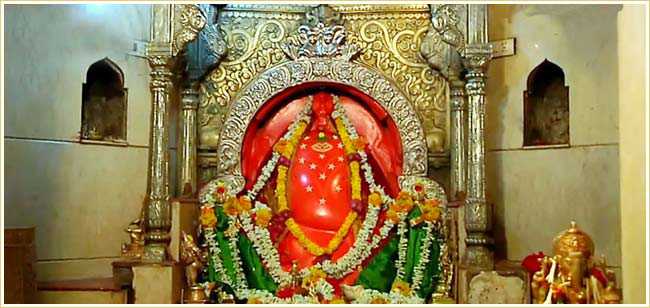
Lord Ganesha, in return, promised the gods to take birth as goddess Parvati’s son and kill Sindhu who was actually a demon in human form. As part of the story, Parvati worshiped the clay idol of Lord Ganesha on the day of BhadrapadashuddhaChaturthi before the idol assumed a real form. When Ganesha was a boy of ten years, Shiva and Parvati left Mount Meru and decided to resettle at Mount Kailash. On their way to Kailash, Ganesha entered into a series of fights with demons and defeated all of them with the help of Siddhi (Shakti) and Buddhi (Intelligence).
He first killed Kamalasura and next he found out the Gandaki Nagari of King Sindhu and framed an action plan along with Lord Shiva’s army. In a powerful fight, Ganesha first killed the two sons of King Sindhu and then proceeded towards killing the king. Sindhu’s confidence on his nectar was such that he neglected the warnings given by his father, Chakrapani. Lord Ganesha came riding on a peacock and with his Parashu he killed Sindhu in one go. Ganesha was thus named ‘Mayureshwar’, the one riding a peacock. After the fight was over, Ganesha decided to reside at Morgaon in his Mayureshwar form for the sake of his devotees.
Suggesting a Muslim influence on the architecture, at each of the four corners in the temple there are the minarets and the temple is surrounded by a tall stone boundary wall.
The Morgoan Ganesha temple has four gates, each facing a cardinal direction and with an image of Ganesha, each gate depicting him in the form that he appeared in each of the four ages (yugas). Each of the four Ganesha forms is associated with a Purushartha (aim of life) and accompanied by two attendants. The image of Ballalvinayaka at the eastern gate, accompanied by god Rama (Vishnu’s Avatar) and his consort Sita, symbolizes Dharma (righteousness, duty, ethnics) and embodies the preserver-god Vishnu. Vignesha at the southern gate, flanked by Ganesha’s parents Shiva and Parvati (Uma) symbolizes Artha (wealth and fame) and embodies the dissolver – Shiva. Chintamani at the western gate – representing Kama (desire, love and sensual pleasure) – is attended by the love god Kamadeva and his wife Rati and embodies the formless (asat) Brahman. Mahaganapati at the northern gate standing for moksha (salvation) is accompanied by Varaha (Vishnu’s boar avatar) and his wife the earth goddess Mahi embodies Sat Brahman.
The quadrangular courtyard has two Deepmalas – lamp towers with niches to light lamps. A sculpted 6 foot mouse – the vahana (mount) of Ganesha sits in front of the temple. A Nagara-khana – which stores Nagaras (kettle drums) – is situated nearby. A huge Nandi bull sculpture is positioned facing the Lord, just outside the temple gates. This is considered unusual as a Nandi is normally positioned in front of the sanctum sanatorium in Shiva temples. A legend explains this oddity: the Nandi sculpture being transported from nearby Shiva temple, decided to settle in front of Ganesha and then refused to move. Both the mouse and Nandi are considered guardians of the entrance.
A recently built sabha-mandapa (assembly-hall) has idols of god Vishnu and his consort Lakshmi. It leads to central hall built by King Kurundwad Patwardhan. The ceiling of this hall is formed from a single stone.
Central image of Ganesha
The garbhagriha (sanctum sanatorium) has a central image of Ganesha as Mayureshwar or Moreshwar, facing the North. The Ganesha image is depicted in a seated posture with its trunk turning to the left, four arms and three eyes. He holds a noose (pasha) and elephant goad (ankusha) in his upper hands, while his lower right rests on his knee and the other one holds a modaka (a sweet). The navel and the eyes are embedded with diamonds. A cobra hood raised over Ganesha’s head, shelters the Lord. The image is actually smaller than it looks as it is smeared with a thick level of saffron-coloured sindoor (vermillion), which peels off once every century. It last fell off in 1882, and prior to that in 1788. Ganesha is flanked by idols of his consorts Riddhi and Siddhi sometimes called Siddhi and Buddhi. These idols are made of an alloy of five metals or of brass. The deities are covered with crafted silver and gold. Like all Ashtavinayaka shrines, the central Ganesha image is believed to be svayambhu (self-existent), naturally occurring in the form of an elephant-faced stone.
The space around the sabha-mandapa (assembly hall) has 23 different idols depicting various forms of Ganesha. The Ganesha idols include the images of the eight avatars of Ganesha described in MudgalaPurana – Vakratunda, Mahodara, Ekadanta, Vikata, Dhrumavarna, Vighnaraja and Lambodara – positioned in eight corners of the temple. Some of the images are installed by the Yogendra Ashram followers. One more noteworthy Ganesha idol is of “SakshiVinayaka” who is “a witness” to the prayers offered to Mayureshwara. Traditionally, first “NagnaBhairava” is prayed then Mayureshwara and then Sakshi Vinayaka. This is the perfect sequence for prayers offered here.
There are other images of Hindu deities around the sabha-mandapa including those of the regional deities Vithoba and Khandoba, personifications of Shuklachaturthi and Krishna chaturthi (the 4th lunar day in bright fortnight and dark fortnight of a lunar month, both of which are sacred for Ganesha worship) and the Ganapatya saint MoryaGosavi. On the circumambulation path (Pradakshina path), there is a Tarati tree (a thorny shrub) near the KalpavrushkaMandir. The tree is believed to be the spot where MoryaGosavi underwent penance. There are two sacred trees in the courtyard: shami and bilva.
On Ganesh Jayanti(Magha) and Ganesh Chaturthi(Bhadrapada) devotees flock to the Mayureshwar temple in large numbers. On both occasion, a procession of pilgrims arrives from Mangalmurti temple, Chinchwad (established by MoryaGosavi) with the palkhi (palanquin) of Ganesha. The Ganesha Chaturthi celebrations last for more than a month, until AshvinShukla ((10th lunar day in the bright fortnight of the Hindu month Ashvin). Fairs and celebrations also occur on Vijayadashami, ShuklaChaturthi (the 4th lunar day in the bright fortnight of a Hindu month), Krishna Chaturthi (the 4th lunar day in the dark fortnight of a Hindu month) and SomavatiAmavasya (a new moon night coinciding with a Monday).
Puja Schedule:
5a.m.: Prakshal Puja (ceremonious bathing of idol)
7a.m.: Shodashopachar Pooja (puja with 16 rituals, including lighting incense, offering flowers, etc)
12 noon: Shodashopachar Pooja (second time in the day)
8p.m.: Panchopachar Puja (pooja done with 5 items, namely rice, incense, diya, flowers & a sweet or a fruit)
10p.m.: Shej-Aarti (aarti at night, considered to be an offering of sleep to the idol)
By Road
Located in Baramatitaluka in Pune district, the place is well connected by good roads. There are frequent state transport service buses that ply from Pune to Baramati. The distance between Pune and Baramati is 64 kms.
By Rail
Jejuri (15 km) is the nearest railway station.
By Air
The nearest airport is the Pune airport.
Ashtavinayak Mayureshwar – Morgoan Ganesha Temple
One thought on “Ashtavinayak Mayureshwar – Morgoan Ganesha Temple”
Leave a Reply
You must be logged in to post a comment.




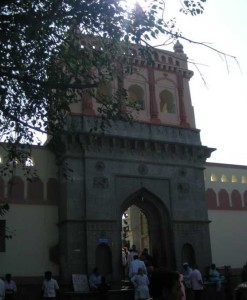

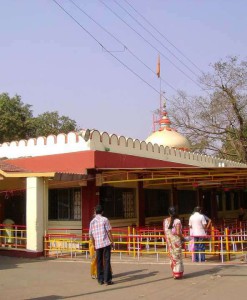
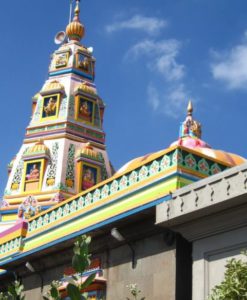
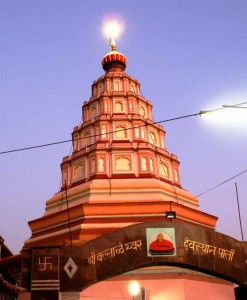
An east facing image of the Lord Ganesha along with his consorts Siddhi and Riddhi are seen here. It is quite interesting when we learnt that the peacock mount, the spear and cobra which the Ganesha has are attributes of Kartikeya, his brother. The Moreshwara Puja is done here thrice a day . It starts in the morning by around 5 am. and the temple remains open for darshanam for a very long time .In this temple we attended a program called the Anna Santarpana where in neivedyam from different houses were gathered and was distributed among the devotees as Mahaprasad.